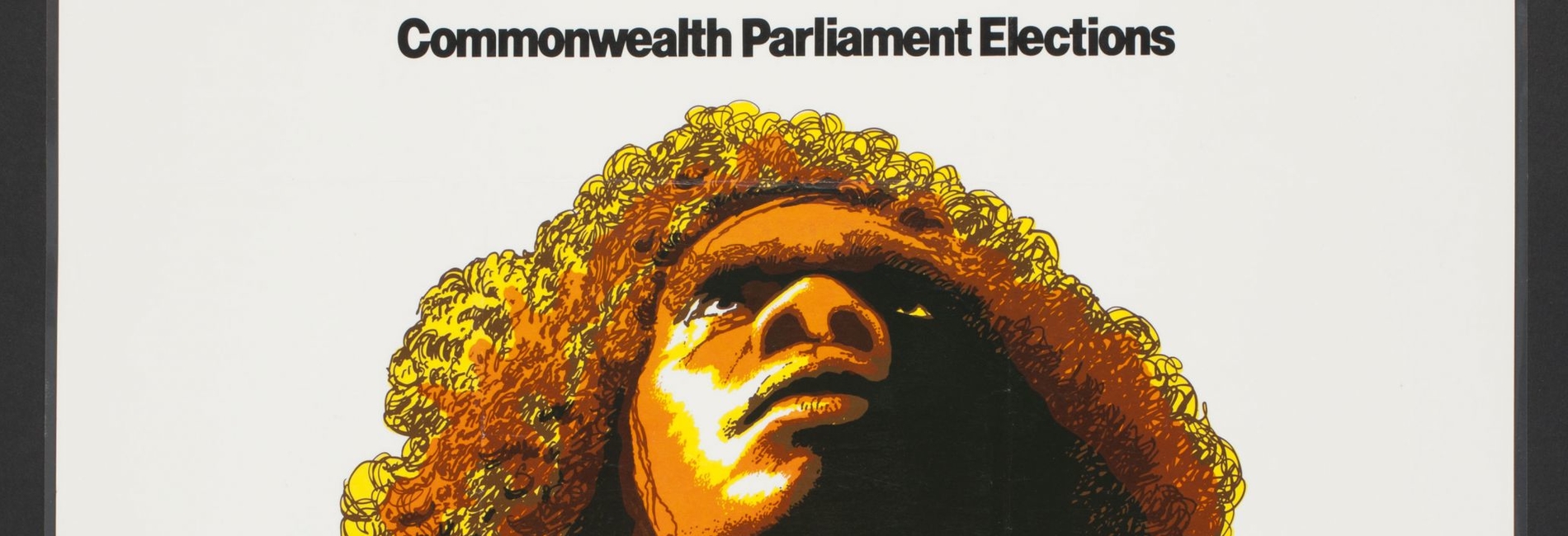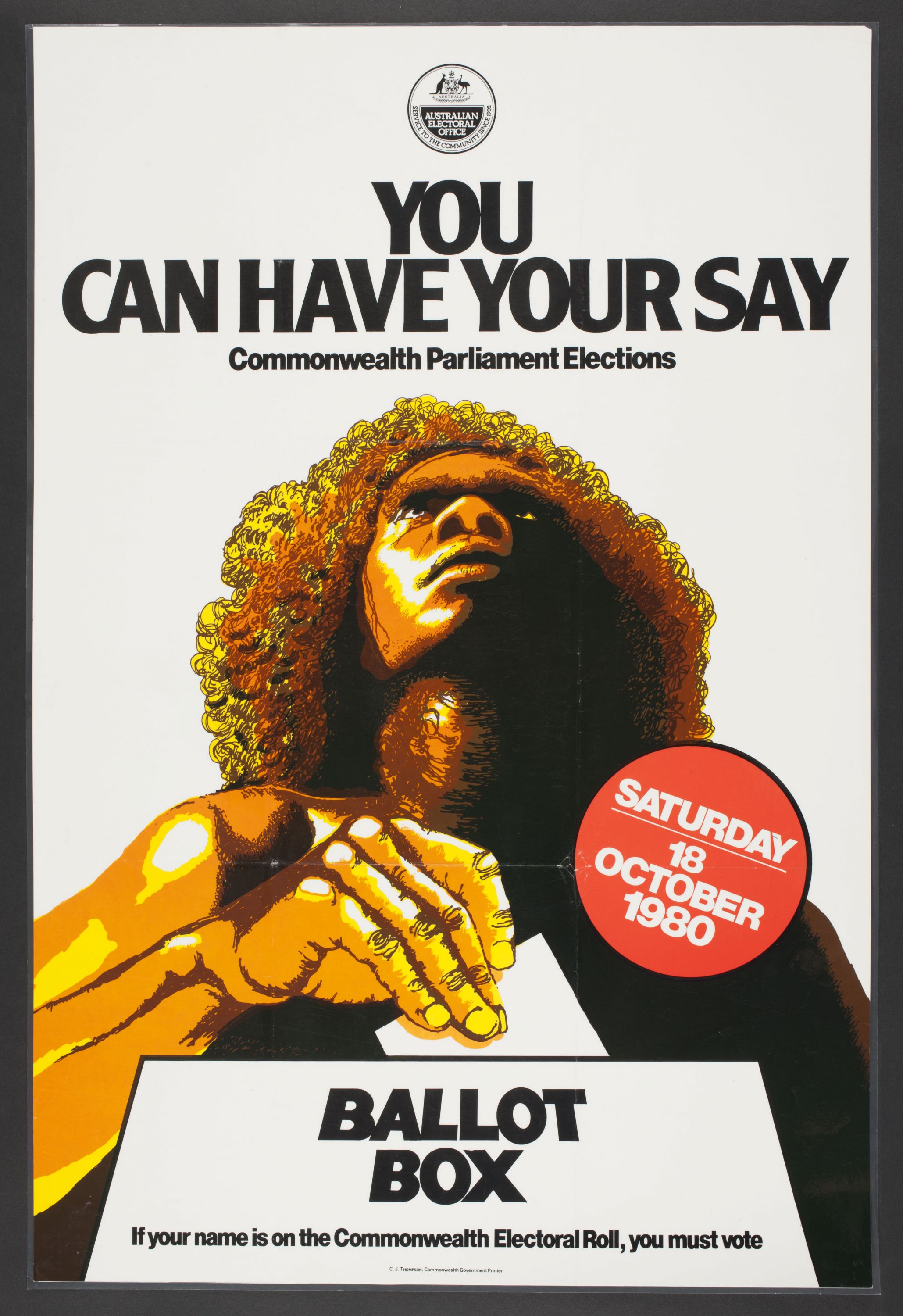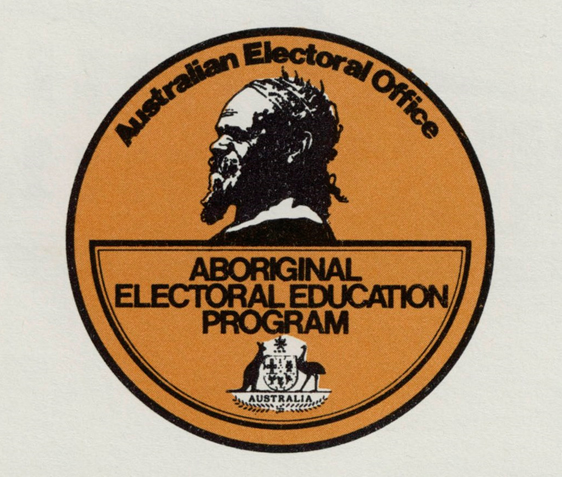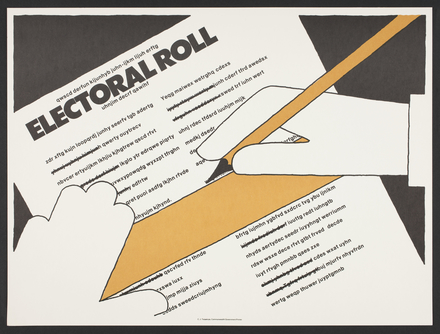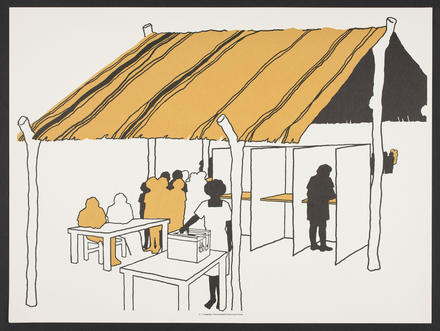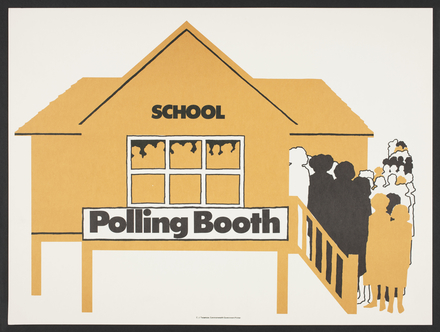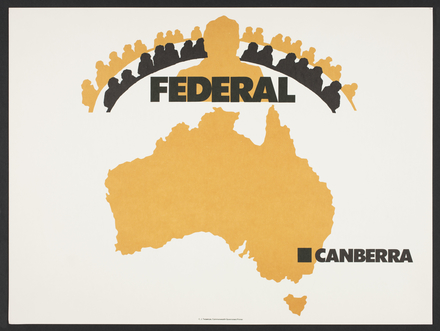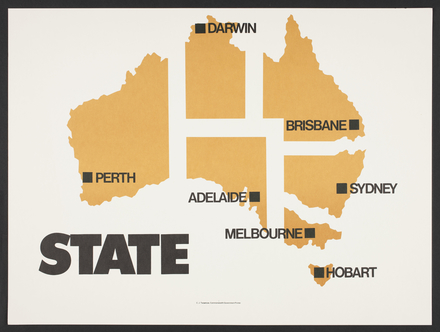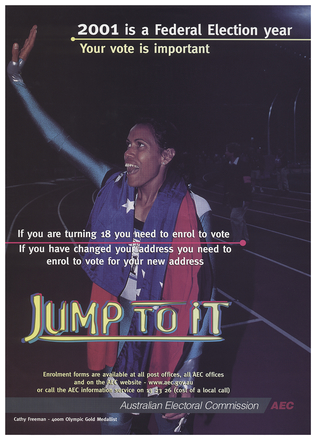The material shown here is of a historical nature and does not reflect current electoral procedures. For current information please visit the Australian Electoral Commission website. Some material may contain descriptions and terms that reflect the authors’ views, or those of the period in which the content was created and may not be considered appropriate today.
Before federation
Contrary to popular misconceptions, Aboriginal and Torres Strait Islander peoples did not gain the vote in the 1967 Referendum. In fact, before Federation in 1901, some Aboriginal people had been entitled to vote in a number of Australian colonies.
Each colony could determine who was allowed to vote which sometimes led to some curious differences. For example, Aboriginal women in South Australia were able to vote in 1894, years before non-Indigenous women could vote in either Sydney or Melbourne.
While in Queensland and Western Australia, Aboriginal and Torres Strait Islander peoples were barred from voting in elections from the end of the nineteenth century until the 1960s.
Federal voting
After Federation, there was heated debate about who should be eligible to vote in the elections for the newly-established Australian government. There was very strong opposition by a significant number of politicians who campaigned against giving all Aboriginal and Torres Strait Islander adults the right to vote.
Senator Alexander Matheson expressed the view that such a step would be ‘repugnant and atrocious’. Senator Richard O’Connor, on the other hand, made a passionate plea for equality for Aboriginal and Torres Strait Islander peoples.
‘It would be a monstrous thing, an unheard of piece of savagery on our part, to treat Aborigines, whose land we were occupying, to deprive them of any right to vote in their own country simply on the grounds of their colour.’ (1902)
Despite O’Connor’s compelling argument, the Commonwealth Franchise Act of 1902 further restricted Aboriginal voting rights. Aboriginal and Torres Strait Islander peoples were barred from participating in Commonwealth elections unless they were already eligible to vote in state elections.
Under the Constitution, individual states had the right to legislate the definitions of who was considered to be an Aboriginal and or Torres Strait Islander person. These definitions could be used to determine who was and who was not eligible to vote.
During the first half of the twentieth century, changes to the definitions often led to further restrictions on voting rights. Because of these policies, many Aboriginal and Torres Strait Islander peoples were excluded from participating in the political process.
Voting rights for all
‘I ask for franchise for all people of Aboriginal blood’ — Sir Douglas Nicholls, footballer, pastor and activist, 1961
Throughout the first half of the twentieth century, a growing number of Aboriginal and Torres Strait Islander campaigners sought to gain rights for, and improve the living conditions of Aboriginal and Torres Strait Islander peoples. Over time, their efforts led to changes in legislation.
In 1949, the Electoral Act was amended to extend the federal vote to Aboriginal and Torres Strait Islander peoples who had served in the armed forces, and to continue to enfranchise those who had the right to vote in their own state.
In 1961, following sustained campaigning by activist groups such as the Federal Council for Aboriginal Advancement, the Federal Government convened a Select Committee on Voting Rights of Aborigines. The Committee’s Report estimated that approximately 30,000 people living in the Northern Territory, Queensland and Western Australia were excluded from the vote.
As a result, the Commonwealth Electoral Act was amended in 1962 to give all Aboriginal and Torres Strait Islander adults the right to vote in federal elections, although enrolling was not made compulsory.
Legislators were concerned that some Aboriginal and Torres Strait Islander peoples might choose not to exercise their right to vote and might be penalised for not voting. For this reason, the Act stressed that enrolment was optional.
The new Act also made encouraging Aboriginal and Torres Strait Islander adults to enrol an offence. This unusual situation remained in effect until 1984 when voting was made compulsory for all Aboriginal and Torres Strait Islander adults in line with the rest of the nation.
With the expansion of voting rights, a wide range of material was produced to inform diverse groups of Aboriginal and Torres Strait Islander peoples of their rights and obligations in relation to voting.
The AIATSIS Collection includes information and promotional materials that chart the changing approaches to Aboriginal and Torres Strait Islander participation in the electoral process. The materials chart changing official approaches to Aboriginal and Torres Strait Islander participation in the electoral process over half a century. They also form a powerful record of the evolving engagement of Aboriginal and Torres Strait Islander peoples in Australia’s democratic system.
The education campaigns
An instruction in voting
In September 1962, Charles ‘Jack’ White, a senior official with the Commonwealth Electoral Office (the forerunner to the Australian Electoral Commission), initiated an education program to provide information to Aboriginal voters. The program was designed specifically for use in the Northern Territory which was where the first election following the 1962 Act was held. It sought to instruct adults who had just gained the right to vote, and to educate future generations of voters.
At the time, election education materials consisted of English-language pamphlets with no illustrations. White commissioned the production of more versatile visual aids — a filmstrip and picture cards — that could be used to deliver instruction in Aboriginal languages as well as English.
The filmstrip ‘Franchise for Aborigines’ was a series of images that could be projected onto a screen or wall. It was the first effort to illustrate the Australian parliamentary system and voting procedures for an audience presumed to have little knowledge of either.
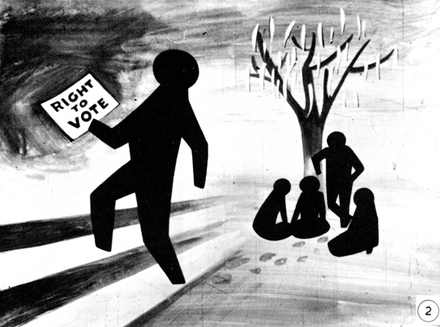
'The change in the law which gives to aborigines the "right to vote"—an important step in the advancement of the aborigines.' Franchise for Aborigines filmstrip, 1962. Art Direction by Newman Rosenthal, artwork by Eric Thake. Produced by the Department of Audio-Visual Aids, the University of Melbourne for Commonwealth Electoral Office.
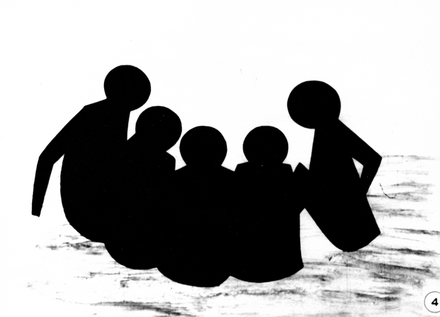
'The importance of the electoral process and the need to first talk about and learn as much as possible about the meaning and purpose of enrolment and voting, so as to gain a reasonable understanding before making a decision whether or not to enrol.' A major theme of the electoral education program was that unlike other adult Australian citizens for whom enrolment and voting was compulsory, Aboriginal and Torres Strait Islander individuals could choose whether or not they enrolled. The same legislation that extended voting rights to all Aboriginal and Torres Strait Islander adults also made it an offence to encourage them to enrol, a situation which remained unchanged until 1983.Franchise for Aborigines, 1962. Art Direction by Newman Rosenthal, artwork by Eric Thake. Produced by the Department of Audio-Visual Aids, the University of Melbourne for Commonwealth Electoral Office.
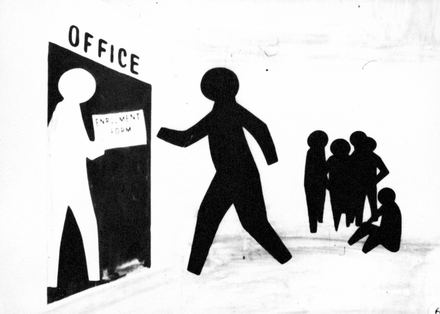
'Enrolment for aborigines is voluntary and the different aspects which may result from the discussions: (i) a man may decide to enrol and then takes necessary action to obtain and complete an electoral claim card; (ii) a man may reject the franchise by deciding not to enrol and consequently need take no further action; (iii) others may continue to think about or discuss the implications of enrolling without having made a decision.' This image depicts the different options available to Aboriginal adults in the Northern Territory. The seated figure is intended to represent a person who has decided not to enrol. Franchise for Aborigines, 1962. Art Direction by Newman Rosenthal, artwork by Eric Thake. Produced by the Department of Audio-Visual Aids, the University of Melbourne for Commonwealth Electoral Office.
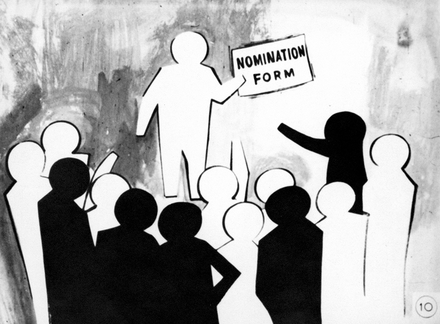
'Nominations and nominators and the entitlement of aborigines to take part.' At the time that the filmstrip was produced, it was widely thought that Aboriginal and Torres Strait Islander peoples would not understand the political system sufficiently to run for office. In this image though a mixture of people are taking part in the nomination process, the figure of the nominee is white. Franchise for Aborigines, 1962. Art Direction by Newman Rosenthal, artwork by Eric Thake. Produced by the Department of Audio-Visual Aids, the University of Melbourne for Commonwealth Electoral Office.
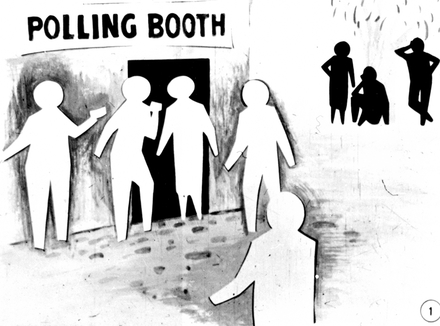
'The position in the Northern Territory prior to the amending legislation.' The first images in the filmstrip convey the impact of the 1962 legislation that ensured all Aboriginal and Torres Strait Islander peoples had the right to vote in federal elections. This image depicts the situation in the Northern Territory before this legislation was passed: a group of white figures enter the polling booth while a group of black figures, representing Aboriginal people who are excluded from the voting process, look on from under a tree. Franchise for Aborigines, 1962. Art Direction by Newman Rosenthal, artwork by Eric Thake. Produced by the Department of Audio-Visual Aids, the University of Melbourne for Commonwealth Electoral Office.
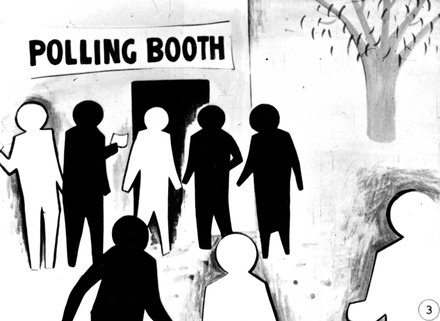
What will happen at future elections—aborigines and whites may join together with equal rights in voting.' Franchise for Aborigines, 1962. Art Direction by Newman Rosenthal, artwork by Eric Thake. Produced by the Department of Audio-Visual Aids, the University of Melbourne for Commonwealth Electoral Office.
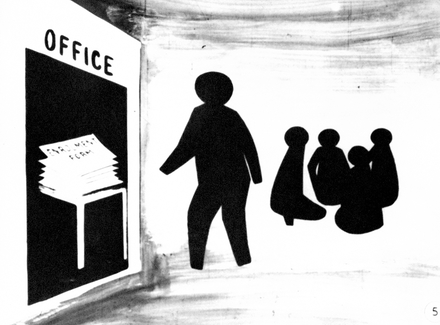
'What action a man who has learnt and understands the implications of enrolment […] takes to secure enrolment.' Those wishing to enrol are instructed to obtain an electoral claim form. Franchise for Aborigines, 1962. Art Direction by Newman Rosenthal, artwork by Eric Thake. Produced by the Department of Audio-Visual Aids, the University of Melbourne for Commonwealth Electoral Office.

'Assistance which may be given in completing a claim for enrolment if required.' This image depicts the electoral assistant as a white figure. Later materials feature Aboriginal and Torres Strait Islander electoral assistants, reflecting their growing participation in the voting process. Franchise for Aborigines, 1962. Art Direction by Newman Rosenthal, artwork by Eric Thake. Produced by the Department of Audio-Visual Aids, the University of Melbourne for Commonwealth Electoral Office.
This filmstrip was prepared by the University of Melbourne Department of Audio-Visual Aids for the Commonwealth Electoral Office (the predecessor to the Australian Electoral Commission). Charles White, a Commonwealth Electoral Officer, approached the Department to produce the filmstrip in August 1962. He wrote the script drawing on his previous experience working on electoral education in Papua New Guinea. Eric Thake, who drew the artwork, had previously designed the decorative panels for the Museum of Victoria’s Aboriginal life and culture display.
The filmstrip focused on the mechanics of the voting process with little discussion of the functions of government and how voting might impact on peoples’ lives.
These early education materials established a set of images that visualised the participation of Aboriginal and Torres Strait Islander peoples in the Australian democratic system. They reoccur in many of the later materials, with subtle differences reflecting changing government policies and the growing recognition of Aboriginal and Torres Strait Islander peoples as active participants in the political process.
An urban audience
The extension of federal voting rights to all Aboriginal and Torres Strait Islander peoples, together with the continuing efforts of Aboriginal campaigners and their supporters, contributed to the expansion of voting rights to all Aboriginal and Torres Strait Islander adults in state elections.
Voting rights for Aboriginal people in Western Australia were extended in 1962; the Native Welfare Act, passed in 1963, repealed earlier Acts which had restricted the civil liberties of Aboriginal people in Western Australia.
In 1964, the Western Australian Department of Native Welfare produced the pamphlet Citizens to explain these legislative changes to Aboriginal people. It is the earliest item in the Collection that explicitly communicates with an urban Aboriginal audience.

Unlike the other materials from the 1960s and 1970s this pamphlet was written for a predominantly urban audience of Aboriginal people in south-western Western Australia. This is reflected in the cover artwork and the illustrations inside.
The artwork for the cover is a photomontage featuring photographs of five people. If you can identify any of these individuals, please let us know. Citizens, c.1964, Western Australian Department of Native Welfare. AIATSIS Collection p WES.
Unlike the other materials from the 1960s and 1970s this pamphlet was written for a predominantly urban audience of Aboriginal people in south-western Western Australia. This is reflected in the cover artwork and the illustrations inside.
The artwork for the cover is a photomontage featuring photographs of five people. If you can identify any of these individuals, please let us know. Citizens, c.1964, Western Australian Department of Native Welfare. AIATSIS Collection p WES.
In 1965, the Commonwealth Electoral Office updated the visual aids, using similar layouts to the 1962 filmstrip but with naturalistic drawings replacing the abstract silhouettes.
Like the 1962 materials, the images on these cards are designed for Aboriginal audiences in rural and remote communities, predominantly in Western Australia where Jack White had taken the role of Chief Commonwealth Electoral Officer for that state.
In 1965, Queensland was the last state to fall in line and pass legislation allowing all Aboriginal and Torres Strait Islander adults to vote in state elections.
The increasing public awareness of Aboriginal and Torres Strait Islander electors during the 1960s is demonstrated by a Weet-Bix card produced in 1969.
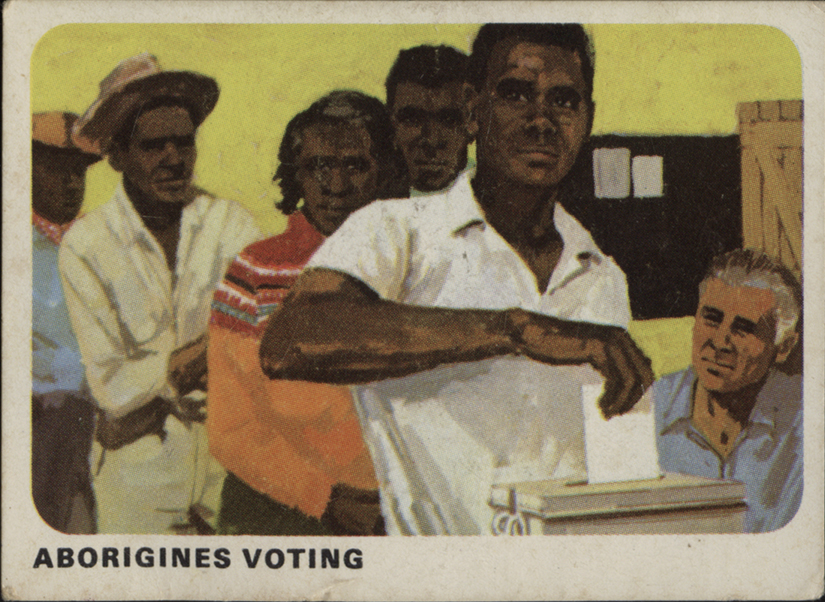
‘Aborigines Voting’, card No. 17 from The World of the Aborigine, 1969. Australian Health & Nutrition Association Limited trading as Sanitarium Health & Wellbeing Company. AIATSIS ephemera.
‘Aborigines Voting’, card No. 17 from The World of the Aborigine, 1969. Australian Health & Nutrition Association Limited trading as Sanitarium Health & Wellbeing Company. AIATSIS ephemera.
The card was one of a collectable series of cards distributed in Weet-Bix cereal boxes, depicting various aspects of Aboriginal lives and cultures. It features an image of Aboriginal people exercising their right to vote. The accompanying text was emphatically positive about the impact of extended voting rights:
‘[…] increasing numbers of Aborigines are voting at each election. The day may not be far away when an Aborigine will be elected to Parliament’.
Indeed, the day was not far off. In 1971, Neville Bonner was appointed by the Queensland Liberal Party to fill a vacancy as a senator for Queensland, becoming the first Aboriginal person to sit in the Commonwealth Parliament. It was a historic appointment and he was subsequently returned to office in the 1972 election.
‘First and foremost I participate […] as an Australian citizen. […] As an Australian, I am concerned for the future of my country, for the welfare of its people and for the quality of life that they enjoy.’ — Neville Bonner, maiden parliamentary speech, 1971.
Materials in language
The 1970s saw the growing assertion of distinct Aboriginal and Torres Strait Islander identities. This social context was reflected in electoral education materials that featured more active roles for Aboriginal and Torres Strait Islander peoples in the electoral process, as well as the production of these materials in Aboriginal languages.
Much of this material was produced for voters living in remote communities in Western Australia, as well as in remote areas of the Northern Territory and South Australia.
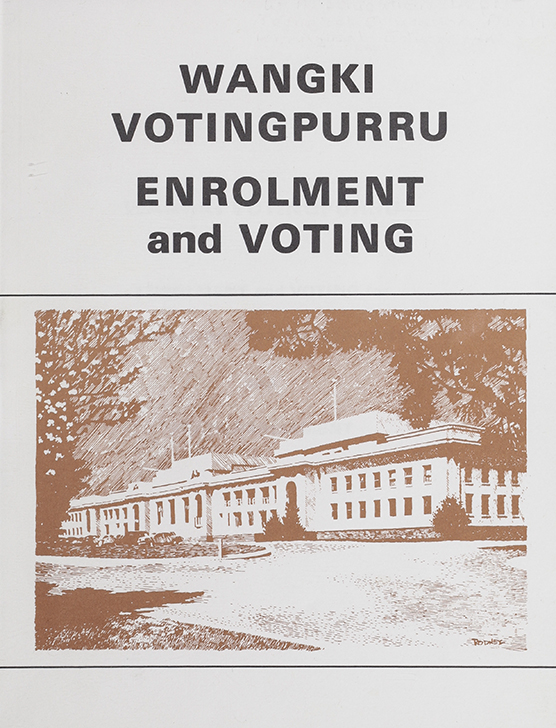
This is a 1975 translation into the Walmatjari (Walmajarri) language of the 1970 booklet Enrolment and Voting. The booklet was produced for Walmatjari speakers living in the towns of Fitzroy Crossing, Halls Creek and Derby in the Kimberley region of Western Australia. It is the earliest known example of electoral education material being translated into a written Aboriginal language. It was produced by the renamed Adult Aboriginal Education Division for its Community Obligations program. The booklet was reprinted in 1977 as part of the voting procedures course held in the Kimberley in 1977. Wangki Votingpurru, 1975. Adult Aboriginal Education Division, Department of Education of Western Australia. AIATSIS Collection L W254.032/1.
This is a 1975 translation into the Walmatjari (Walmajarri) language of the 1970 booklet Enrolment and Voting. The booklet was produced for Walmatjari speakers living in the towns of Fitzroy Crossing, Halls Creek and Derby in the Kimberley region of Western Australia. It is the earliest known example of electoral education material being translated into a written Aboriginal language. It was produced by the renamed Adult Aboriginal Education Division for its Community Obligations program. The booklet was reprinted in 1977 as part of the voting procedures course held in the Kimberley in 1977. Wangki Votingpurru, 1975. Adult Aboriginal Education Division, Department of Education of Western Australia. AIATSIS Collection L W254.032/1.

This booklet was produced by the Adult Native Education Division of the Western Australian Education Department in 1970 as part of its Community Obligations program. It draws upon the Citizens booklet as well as the 1965 poster cards for much of its imagery. Adult Native Education, Technical Education Division, Education Department of Western Australia, 1970. AIATSIS Collection AIATSIS p WES.
This booklet was produced by the Adult Native Education Division of the Western Australian Education Department in 1970 as part of its Community Obligations program. It draws upon the Citizens booklet as well as the 1965 poster cards for much of its imagery. Adult Native Education, Technical Education Division, Education Department of Western Australia, 1970. AIATSIS Collection AIATSIS p WES.
In 1977, the Australian Electoral Office (AEO), as it was then called, intensified its education efforts. That year saw a federal election in December, as well as a number of state elections and an election to choose candidates for the National Aboriginal Conference (NAC).
As with previous efforts, the education program primarily focused on the mechanics of voting.
Popular Yorta Yorta country music performer Jimmy Little appeared in an AEO instructional film called ‘What you should know for election day’. Jimmy Little provided information on a number of electoral topics, including absentee and postal voting, and performed several of his well-known songs.
Little’s popularity across Aboriginal communities made him the ideal choice for this film, the first to feature a celebrity to promote engagement with the electoral process.
Instructional posters in a range of Aboriginal languages were produced for display at polling booths for the 1977 federal election. The selection of languages focused on languages spoken in the Northern Territory, Western Australia and South Australia, such as Garrwa, Iwaidja, and Arrente.
The AEO also distributed cassette tapes featuring Slim Dusty, another country music singer popular among many Aboriginal and Torres Strait Islander communities, to explain the NAC election process. On the reverse side of the tapes, this information was translated into 17 Aboriginal languages.
'This is the way to make a vote' was developed by the Adult Aboriginal Education Section of the Western Australian Education Department in conjunction with the AEO. The comic book uses the character of an Aboriginal electoral officer to explain the intricacies of preferential voting which was produced for communities in Western Australia.
It was part of a Voting Procedures Course undertaken by the AEO in November and December of 1977 to prepare Aboriginal voters in the Western Australian seat of Kimberley for a state by-election. The by-election was the result of a successful court challenge that found a number of procedural irregularities which had significantly impacted on non-literate Aboriginal voters in an earlier state election.

'This is the way to make a vote on ballot paper', 1977. Adult Aboriginal Education Division Department of Education of Western Australia. AIATSIS Collection p WES.
'This is the way to make a vote on ballot paper', 1977. Adult Aboriginal Education Division Department of Education of Western Australia. AIATSIS Collection p WES.
You can have your say
Building on the intensified education efforts begun in 1977, the Aboriginal Electoral Education Program (AEEP) was established in June 1979.
The new program, called ‘You Can Have Your Say’, shifted from earlier efforts that only addressed the mechanics of the electoral process, to a central message emphasising active participation in the democratic process. The bold imagery reflected 1970s design as well as the iconography of the decade’s activism.
The program initially was carried out in Western Australia and South Australia before being expanded to the Northern Territory.
Two teams travelled with caravans to Aboriginal communities for four or five days and did electoral education classes in consultation with community elders and leaders. The program also distributed packages of the electoral education material for continued use in Aboriginal communities
The education package included new audio-visual material featuring Jimmy Little, sample ballot papers and a set of poster cards.
While the purpose of the program was to teach an understanding of the parliamentary and electoral system, legislation was still in effect that made it an offence to encourage Aboriginal and Torres Strait Islander adults to enrol to vote.
Despite this, the program not only provided instruction on the basics of electoral procedures, it also sought to encourage ‘Aboriginal people to value the rights and obligations implicit in the parliamentary system’.
Unlike earlier education material, it portrayed Aboriginal people as active participants in the electoral process, including images of an Aboriginal candidate.
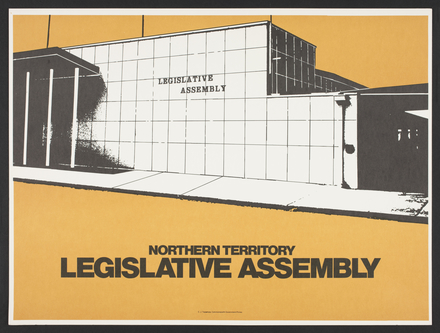
'Parliament House [sic], Darwin'. You can have your say poster cards. Australian Electoral Office, 1979.
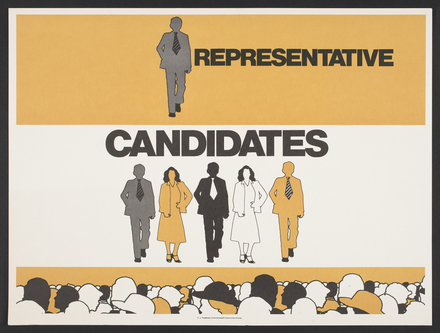
This poster was produced for the federal election held on Saturday 18 October 1980. You Can Have Your Say poster, Australian Electoral Office, 1980.
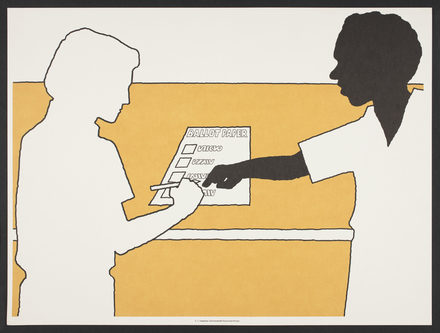
'Presiding officer helping to vote'. You can have your say poster cards, Australian Electoral Office, 1979.
Compulsory voting
‘More than ever, Governments are sitting up and taking notice of Aboriginal people. More than ever, the Aboriginal voice is being listened to.’ — Aboriginal Votes Count pamphlet
The 1980s saw a more visible presence of Aboriginal and Torres Strait Islander cultures in Australian public life, along with greater awareness of the struggles faced by Aboriginal and Torres Strait Islander people.
In 1983, amendments to the Electoral Act made enrolment compulsory for all Australians, including Aboriginal and Torres Strait Islander adults. The earlier restriction against encouraging Aboriginal and Torres Strait Islander adults to enrol was removed. This change required a concerted effort on the part of the re-named Australian Electoral Commission (AEC) to ensure the enrolment of Aboriginal and Torres Strait Islander voters, who may not have previously been enrolled.
In 1985, the AEEP was replaced with the Australian Aboriginal Electoral Information Service (AEIS). The AEC’s new service was different to previous efforts in that it aimed for Aboriginal and Torres Strait Islander self-management in electoral matters. This aim was in keeping with wider policy shifts occurring across government.
The AEIS sought to work with Indigenous communities and organisations to promote the enrolment of Aboriginal and Torres Strait Islander voters. The program also included the training of Aboriginal Community Electoral Assistants. The AEIS produced a wide range of education material to promote enrolment, voting and participation in the democratic system.
The Vee Family
A series of 39 booklets were produced by the AEIS to provide electoral education through the experiences of the various members of the fictitious Vee family.
These experiences range from that of a non-literate voter voting for the first time, a person obliged to undertake postal voting and that of a person participating as a candidate in the election.

This booklet tells the story of voting procedures through the experiences of Billy Vee who takes on the role of Community Electoral Assistant. Billy assists various members of his community to enrol and vote. The Vee Family: Billy Vee (Part 3), 1986.
Australian Electoral Commission. AIATSIS Collection B V417.07/V1 READER PART 3.
This booklet tells the story of voting procedures through the experiences of Billy Vee who takes on the role of Community Electoral Assistant. Billy assists various members of his community to enrol and vote. The Vee Family: Billy Vee (Part 3), 1986.
Australian Electoral Commission. AIATSIS Collection B V417.07/V1 READER PART 3.
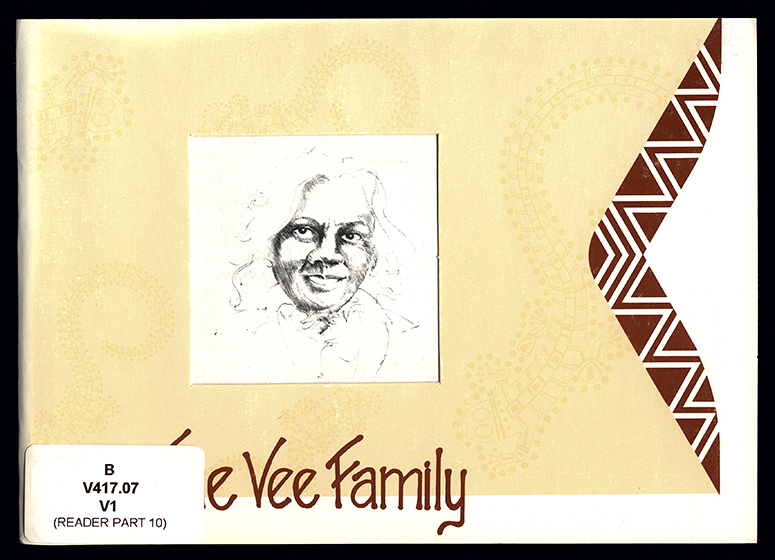
Linda Vee is Terry’s wife. This booklet describes some of the difficulties she encounters trying to cast her vote on election day. 'The Vee Family: linda Vee (Part 3)', 1986, Australian Electoral Commission. AIATSIS Collection AIATSIS B V417.07/V1 READER PART 3.
Linda Vee is Terry’s wife. This booklet describes some of the difficulties she encounters trying to cast her vote on election day. 'The Vee Family: linda Vee (Part 3)', 1986, Australian Electoral Commission. AIATSIS Collection AIATSIS B V417.07/V1 READER PART 3.
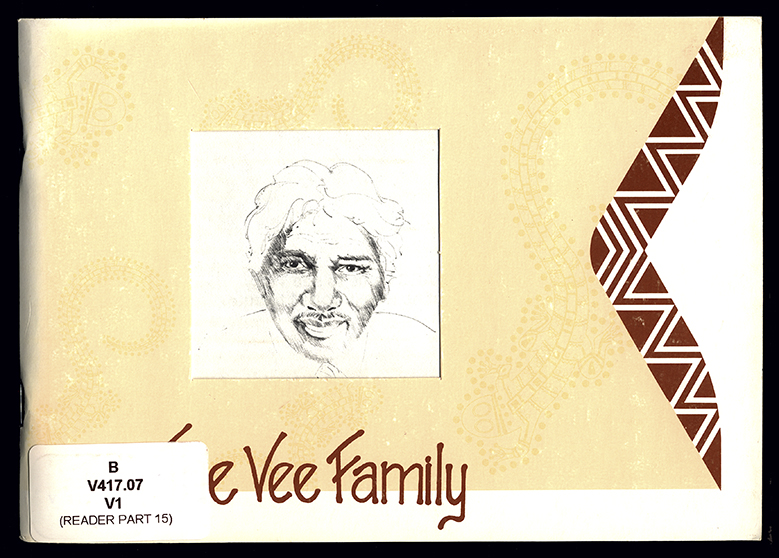
This booklet describes the experiences of Terry Vee who runs as a candidate in an election. One of his opponents on the ballot is Samson, who also appeared as a candidate in the earlier educational material prepared by the AEEP. 'The Vee Family: terry Vee (Part 3)', 1986
Australian Electoral Commission. AIATSIS Collection B V417.07/V1 READER PART 3.
This booklet describes the experiences of Terry Vee who runs as a candidate in an election. One of his opponents on the ballot is Samson, who also appeared as a candidate in the earlier educational material prepared by the AEEP. 'The Vee Family: terry Vee (Part 3)', 1986
Australian Electoral Commission. AIATSIS Collection B V417.07/V1 READER PART 3.
Popular icons
Towards the end of the 1980s, the AEC sought new and more engaging ways to communicate electoral information to Aboriginal and Torres Strait Islander voters. Materials including comic books and vibrant, large format posters were produced.
The message also began to change, emphasising the responsibilities of elected representatives to address the needs and aspirations of their electorates.
Individuals were encouraged to vote as a way to assert their rights as citizens, and their desires for the future for themselves and their communities.
The Phantom Enrols and Votes
In 1988, the popular comic book figure The Phantom was recruited for use in electoral education material. The Phantom was and continues to be a favourite character in Aboriginal and Torres Strait Islander communities and was considered an ideal way to engage with potential voters. Like earlier education materials, the comic book was a format chosen to appeal to a wide range of age groups, including children who would become future voters.
Both comics were designed by Garage Graphix, a not-for-profit community art organisation consisting of Aboriginal and non-Indigenous artists and designers based in western Sydney.
The 1988 comic book The Phantom enrols & votes focused on encouraging enrolment and explaining voting procedures.

'The Phantom Enrols and Votes', 1988. Artwork by Garage Graphix, The Phantom © King Features Syndicate, Inc, TM Hearst Holdings, Inc. Australian Electoral Commission. AIATSIS Collection Rp AUS.
'The Phantom Enrols and Votes', 1988. Artwork by Garage Graphix, The Phantom © King Features Syndicate, Inc, TM Hearst Holdings, Inc. Australian Electoral Commission. AIATSIS Collection Rp AUS.
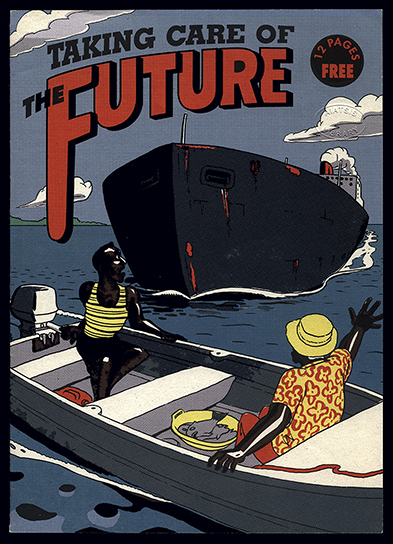
'Taking care of the future', 1993. Artwork by Tony Thorne (Tebrikuna), design & art direction by Redback Graphix, written by Alaistair Legge for the Australian Electoral Commission. AIATSIS Collection Rp AUS.
'Taking care of the future', 1993. Artwork by Tony Thorne (Tebrikuna), design & art direction by Redback Graphix, written by Alaistair Legge for the Australian Electoral Commission. AIATSIS Collection Rp AUS.
The AEC commissioned a series of posters by Aboriginal and non-Indigenous designers from the Redback Graphix artists’ collective in Wollongong. The designers used visual imagery rather than written text to convey the messages.
The posters were recognisable by their distinct and colourful style, and became renowned for their visual appeal.
As Australia entered the twenty first century, Aboriginal and Torres Strait Islander achievements, role models, and contributions began to gain a greater public profile.
The Australian Electoral Commission continued to make ongoing efforts to educate and empower Aboriginal and Torres Strait Islander people, particularly youth, in the electoral process.
A 2001 campaign, 'Jump to it', featured celebrities including singer Christine Anu, AFL player Xavier Clarke and Olympic Gold medallist Cathy Freeman.
'The Vote, it’s important' campaign was produced for the 2004 federal election, and included prominent Aboriginal and Torres Strait Islander role models such as athlete Kyle Vander Kuyp, and Simone Stacey and Naomi Wenitong from the musical group Shakaya.
Visits to communities, and the production of resources in Aboriginal and Torres Strait Islander languages, continued to be an important part of the information given to voters.
‘I vote at every election and I think it is very important that I have a say. I think it is very important that we continue to have a voice.’ — Christine Anu, performer, 2012
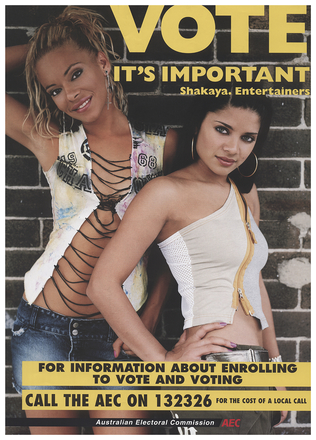
'Jump to it' poster featuring Shakaya, 2001. Australian Electoral Commission. AIATSIS Collection M406.
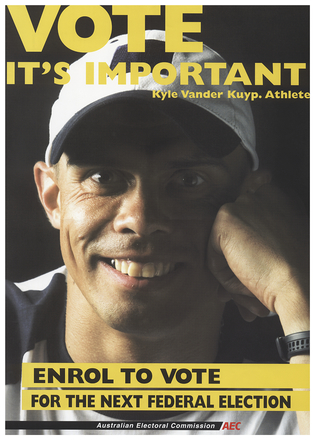
'Jump to it' poster featuring Kyle Vander Kuyp, 2001. Australian Electoral Commission. AIATSIS Collection M406.
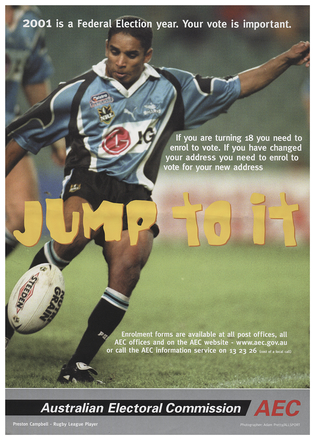
'Jump to it' poster featuring Preston Campbell, 2001. Australian Electoral Commission. AIATSIS Collection M406.

'Jump to it' poster featuring Patrick Johnson, 2001. Australian Electoral Commission. AIATSIS Collection M406.
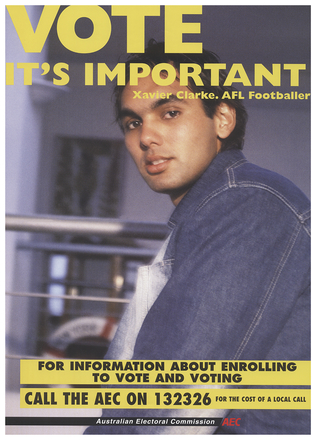
'Jump to it' poster featuring Xavier Clarke, 2001. Australian Electoral Commission. AIATSIS Collection M406.
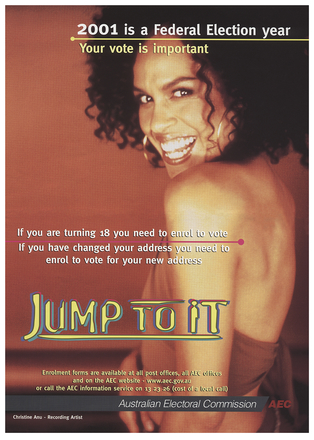
'Jump to it' poster featuring Christine Anu, 2001. Australian Electoral Commission. AIATSIS Collection M406.
Lasting legacy
The year 2012 was the fiftieth anniversary of the amendments to the 1962 Commonwealth Electoral Act that had given all Aboriginal and Torres Strait Islander adults voting rights. The AEC marked the occasion by reprinting three classic Redback Graphix posters, testifying to the lasting legacy and impact of these important endeavours.
To the credit of the AEC and its predecessor organisations, their electoral education materials and campaigns spanning 25 years had inspired similar electoral education programs in countries around the world.

It's your Australia: Make sure you have a say in what happens to it, 1988 (reproduced 2012). Design and printing by Stephen Lees, Redback Graphix for Aboriginal and Torres Strait Islander Electoral Information Service, Australian Electoral Commission.
AIATSIS Collection M 705.
It's your Australia: Make sure you have a say in what happens to it, 1988 (reproduced 2012). Design and printing by Stephen Lees, Redback Graphix for Aboriginal and Torres Strait Islander Electoral Information Service, Australian Electoral Commission.
AIATSIS Collection M 705.
We welcome opportunities to build knowledge about the AIATSIS Collection. If you have additional information about the materials presented here, please contact us.
Acknowledgements
AIATSIS would like to thank the following individuals and organisations for their assistance with this story: Australian Electoral Commission, Bronwyn Barwell, Marla Guppie, Alistair Legge, Marie McMahon, Lin Mountstephen, Paula Nesci, Frances Peters-Little, Will Sanders, Sanitarium Health & Wellbeing Company, The University of Melbourne Archives, and Tony Thorne.
References
Abdullah, Yasmin Jill. Abdullah, George Cyril (1919–1984). In Australian Dictionary of Biography. Canberra: National Centre of Biography, Australian National University.
Australian Electoral Commission. 'Louder than One Voice', Calendar, 2012
Australian Electoral Office. 'The Australian Electoral Office and Aboriginals.' In Service Delivery to Remote Communities, edited by P. (Peter) Loveday. Australian National University, North Australia Research Unit, 1982.
Bolger, Audrey, and Hilary Rumley. 'Scandal in the Kimberleys: Voting Rights for Black Australians.' Legal Service Bulletin 3 (December 1978): 221.
-- 'Voting Rights for Black Australians.' Legal Service Bulletin 4 (1979): 39.
Bonner, Neville Thomas (1922-1999)
Broome, Richard. 'Nicholls, Sir Douglas Ralph (Doug) (1906–1988).' In Australian Dictionary of Biography. Canberra: National Centre of Biography, Australian National University.
Chesterman, John. Civil Rights : How Indigenous Australians Won Formal Equality. University of Queensland Press, 2005.
-- 'Defending Australia’s Reputation How Indigenous Australians Won Civil Rights Part One.' Australian Historical Studies 32, no. 116 (April 1, 2001): 20–39.
Commonwealth Electoral Act 1962
Commonwealth of Australia, Parliamentary debates: Senate: official Hansard, 10 April 1902.
Ducker, P. A., and E. P. Milliken. 'Voting Rights for Northern Territory Aborigines.' Australian Territories 3, no. 1 (1963): 34–37.
'Extension of Franchise to Aboriginal Natives of Australia - Educational Programme in the Northern Territory.' Canberra, 1916-1965. A406, E62/237. National Archives of Australia.
'Extension of Franchise to Aboriginal Natives of Australia [Original File Split into Three Parts].' Canberra, 1962-1965. A406, E1962/237 B. National Archives of Australia, NAA: A406, E1962/237 A, NAA: A406, E1962/237 B, NAA: A406, E1962/237 C.
Goot, Murray. 'The Aboriginal Franchise and Its Consequences.' Australian Journal of Politics & History 52, no. 4 (December 1, 2006): 517–61.
Grant, Kirsty. 'Thake, Eric Prentice Anchor (1904–1982).' In Australian Dictionary of Biography. Canberra: National Centre of Biography, Australian National University.
Hawken, Noel, 'Our Democracy Goes On Location', The Herald, September 6, (1962):4
Hooper, Carole. 'Rosenthal, Newman Hirsh (1898–1986).' In Australian Dictionary of Biography. Canberra: National Centre of Biography, Australian National University.
Jaensch, Dean, and P. (Peter) Loveday, eds. Under One Flag : The 1980 Northern Territory Election / Edited by D. Jaensch and P. Loveday. Sydney ; Boston: Allen & Unwin, 1981.
Joint Standing Committee on Electoral Matters. 'Inquiry into Civics and Electoral Education,' 2007.
Loveday, P. 'The Australian Aboriginal Electoral Information Service.' Australian Journal of Public Administration 47, no. 4 (December 1, 1988): 343–50.
Loveday, P., A. Randall, Will Sanders, and Dean Jaensch. The Aboriginal Electoral Information Service : Report of the Review 1987-88. Australian National University. North Australia Research Unit, 1988.
Noonuccal, Oodgeroo (1929-1993)
Redback Graphix
Reid, Margaret. 'Caste-Ing the Vote: Aboriginal and Torres Strait Islander Voting Rights in Queensland.' Hecate 30, no. 2 (2004): 71-80.
Report from the Select Committee on Voting Rights of Aborigines. Commonwealth Government Printer, 1961.
Rutledge, Martha. 'O’Connor, Richard Edward (Dick) (1851–1912).' In Australian Dictionary of Biography. Canberra: National Centre of Biography, Australian National University.
Sanders, Will. 'Delivering Democracy to Indigenous Australians.' In Elections : Full, Free & Fair, edited by Marian Sawer. Annandale, N.S.W: Federation Press, 2001.
Stretton, Pat, and Christine Finnimore. 'Black Fellow Citizens: Aborigines and the Commonwealth Franchise.' Australian Historical Studies 25, no. 101 (October 1, 1993): 521–35.
Stringer, Ernest. An Evaluation of the Aboriginal Electoral Education Programme. Perth, WA: Western Australian Institute of Technology, 1983.
